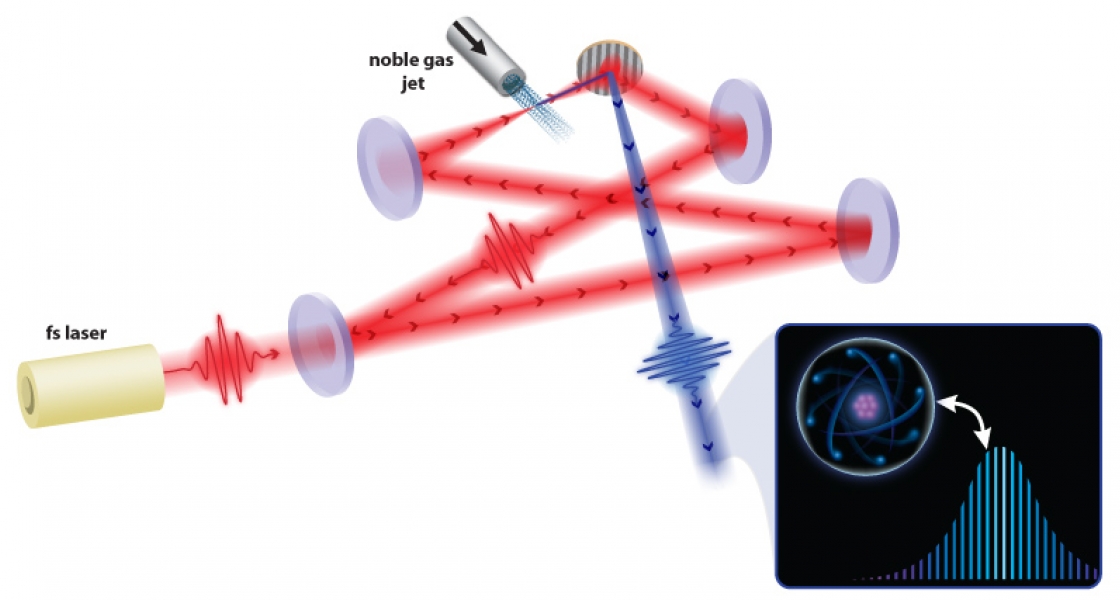Fellow Jun Ye’s group is methodically working its way toward the creation of an X-Ray frequency comb. Recently, senior research associate Thomas Schibli, graduate student Dylan Yost, Fellow Jun Ye, and colleagues from IMRA America, Inc. developed a high-performance, ultrastable fiber laser optical frequency comb. At the same time, Yost developed a clever method for getting coherent short-wavelength light out of a femtosecond enhancement cavity used with the fiber laser. These achievements have opened the door to the generation of frequency combs in the extreme ultraviolet (EUV) and soft X-ray regions of the electromagnetic spectrum.
Schibli’s new fiber-based infrared frequency comb is a high-peak power, high-precision, and superstable device. It is not only one of the most stable frequency combs ever built, but also boasts an average power at a record level of >10 W. These two attributes will be critical for creating phase-stable frequency combs of radiation whose wavelengths are shorter than optical frequencies, i.e., in the vacuum ultraviolet (VUV) and EUV wavelengths.
To create coherent comblike EUV radiation, the fiber frequency comb’s output of a few hundred thousand colors (comb lines) is routed into a passive (broadband) enhancement cavity. There, custom-designed mirrors, which are highly reflective, bounce the light back and forth through the cavity. This process enhances pulse energies by as much as a thousandfold while maintaining the shape of the pulses. The peak intensities of the enhanced pulses are great enough to rip electrons out of xenon atoms fed into the cavity via a gas jet. When the electrons recollide with the xenon atoms, coherent EUV radiation is emitted.
The key challenge at this point has been to get the very short wavelength pulses out of the cavity before they hit the mirrors, which appear black to short-wavelength radiation and cannot reflect or transmit it. Yost recently solved this problem by suggesting that the researchers etch a diffraction grating directly in the surface of one of the mirrors. The grating routes the short-wavelength radiation out of the cavity, while continuing to reflect the fiber laser’s light pulses around the cavity. Yost’s insight was critical for continued progress toward creating an X-ray comb generator. “He saved our bacon,” Schibli noted.
With a way to get VUV and EUV combs out of their enhancement cavity, the researchers are exploring ways to use coherent short-wavelength radiation in their research. For starters, they plan to explore the use of individual comb lines to manipulate quantum coherence inside atoms. For this work, they will follow the lead of newly minted Ph.D. Matt Stowe, who recently used a visible light frequency comb to precisely control electronic transitions in cold 87Rb. Stowe used an enhanced version of direct time/frequency spectroscopy developed by Adela Marian (Ph.D. 2005). He manipulated the frequency comb to control and maintain the long-term quantum coherence of four atomic levels that were separated by large optical frequency gaps.
Such high-precision spectroscopy with high-resolution quantum control could also be implemented with shorter-wavelength frequency combs. In fact, the Ye group is already planning an experiment to use VUV comb lines to control the quantum coherence of specific electronic transitions in argon and helium. Eventually the researchers hope to use comb-based spectroscopy of helium to precisely determine ground-state transitions of this noble gas.
In the future, X-ray comb-based spectroscopy will make it possible to probe structures in atomic nuclei. X-ray combs could also lead to the development of a new generation of atomic clocks based o




